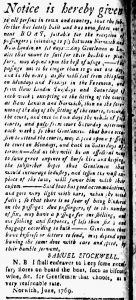What was advertised in a colonial American newspaper 250 years ago today?

“A STAGE-WAGGON … from Sagharbour on Long-Island, to New-York.”
Newspaper advertisements documented some of the transportation infrastructure established in the colonies in the early 1770s. The May 15, 1772, edition of the New-London Gazette, for instance, carried an advertisement for a “STAGE-WAGGON” that operated between New York City and Sag Harbor, a village on Long Island, and an advertisement for “Passage-Boats” that connected New London and Norwich.
Samuel Stockwell and John Springer informed readers who needed to travel or transport goods along the Thames River between New London on the coast and Norwich in the interior of the colony that their boats “Continue to ply every Day, Wind and Weather permitting.” They pledged to keep to their schedule as faithfully as possible. Stockwell and Springer included images of two vessels in their advertisement, simultaneously suggesting their industriousness and the destinations they served.
A more extensive advertisement for the wagon between New York and Sag Harbor explained that the route “will greatly facilitate the travelling between the New England and Southern Provinces. That was made possible by combining travel on the wagon with sailing on “a Passage-Boat kept by James Wiggins” that crossed Long Island Sound between Sag Harbor and New London twice a week. The wagon service departed from both New York and Sag Harbor on Monday mornings. When they met, they exchanged passengers. Travelers arrived at their destination by Wednesday evening. Conveniently, the boat for New London departed “every Thursday Morning, and returns again … on Saturdays.” Passengers sailing that direction arrived in time to catch a wagon headed to New York on Monday morning.
These two advertisements provided sufficient information for readers to plan trips between Norwich and New York, their journey involving two boats and two wagons in a little less than a week. In an advertisement for his own stagecoach service in the Connecticut Journal, Nicholas Brown asserted that “Gentlemen from the Southern Provinces, travelling to Boston … generally go by Water from New-York to Providence.” The advertisements in the New-London Gazetteillustrate other routes available to travelers in New England and New York.



